Canmiao Fu
Text-guided Visual Prompt DINO for Generic Segmentation
Aug 08, 2025Abstract:Recent advancements in multimodal vision models have highlighted limitations in late-stage feature fusion and suboptimal query selection for hybrid prompts open-world segmentation, alongside constraints from caption-derived vocabularies. To address these challenges, we propose Prompt-DINO, a text-guided visual Prompt DINO framework featuring three key innovations. First, we introduce an early fusion mechanism that unifies text/visual prompts and backbone features at the initial encoding stage, enabling deeper cross-modal interactions to resolve semantic ambiguities. Second, we design order-aligned query selection for DETR-based architectures, explicitly optimizing the structural alignment between text and visual queries during decoding to enhance semantic-spatial consistency. Third, we develop a generative data engine powered by the Recognize Anything via Prompting (RAP) model, which synthesizes 0.5B diverse training instances through a dual-path cross-verification pipeline, reducing label noise by 80.5% compared to conventional approaches. Extensive experiments demonstrate that Prompt-DINO achieves state-of-the-art performance on open-world detection benchmarks while significantly expanding semantic coverage beyond fixed-vocabulary constraints. Our work establishes a new paradigm for scalable multimodal detection and data generation in open-world scenarios. Data&Code are available at https://github.com/WeChatCV/WeVisionOne.
WeTok: Powerful Discrete Tokenization for High-Fidelity Visual Reconstruction
Aug 07, 2025Abstract:Visual tokenizer is a critical component for vision generation. However, the existing tokenizers often face unsatisfactory trade-off between compression ratios and reconstruction fidelity. To fill this gap, we introduce a powerful and concise WeTok tokenizer, which surpasses the previous leading tokenizers via two core innovations. (1) Group-wise lookup-free Quantization (GQ). We partition the latent features into groups, and perform lookup-free quantization for each group. As a result, GQ can efficiently overcome memory and computation limitations of prior tokenizers, while achieving a reconstruction breakthrough with more scalable codebooks. (2) Generative Decoding (GD). Different from prior tokenizers, we introduce a generative decoder with a prior of extra noise variable. In this case, GD can probabilistically model the distribution of visual data conditioned on discrete tokens, allowing WeTok to reconstruct visual details, especially at high compression ratios. Extensive experiments on mainstream benchmarks show superior performance of our WeTok. On the ImageNet 50k validation set, WeTok achieves a record-low zero-shot rFID (WeTok: 0.12 vs. FLUX-VAE: 0.18 vs. SD-VAE 3.5: 0.19). Furthermore, our highest compression model achieves a zero-shot rFID of 3.49 with a compression ratio of 768, outperforming Cosmos (384) 4.57 which has only 50% compression rate of ours. Code and models are available: https://github.com/zhuangshaobin/WeTok.
Video-GPT via Next Clip Diffusion
May 18, 2025Abstract:GPT has shown its remarkable success in natural language processing. However, the language sequence is not sufficient to describe spatial-temporal details in the visual world. Alternatively, the video sequence is good at capturing such details. Motivated by this fact, we propose a concise Video-GPT in this paper by treating video as new language for visual world modeling. By analogy to next token prediction in GPT, we introduce a novel next clip diffusion paradigm for pretraining Video-GPT. Different from the previous works, this distinct paradigm allows Video-GPT to tackle both short-term generation and long-term prediction, by autoregressively denoising the noisy clip according to the clean clips in the history. Extensive experiments show our Video-GPT achieves the state-of-the-art performance on video prediction, which is the key factor towards world modeling (Physics-IQ Benchmark: Video-GPT 34.97 vs. Kling 23.64 vs. Wan 20.89). Moreover, it can be well adapted on 6 mainstream video tasks in both video generation and understanding, showing its great generalization capacity in downstream. The project page is at https://Video-GPT.github.io.
Get In Video: Add Anything You Want to the Video
Mar 08, 2025Abstract:Video editing increasingly demands the ability to incorporate specific real-world instances into existing footage, yet current approaches fundamentally fail to capture the unique visual characteristics of particular subjects and ensure natural instance/scene interactions. We formalize this overlooked yet critical editing paradigm as "Get-In-Video Editing", where users provide reference images to precisely specify visual elements they wish to incorporate into videos. Addressing this task's dual challenges, severe training data scarcity and technical challenges in maintaining spatiotemporal coherence, we introduce three key contributions. First, we develop GetIn-1M dataset created through our automated Recognize-Track-Erase pipeline, which sequentially performs video captioning, salient instance identification, object detection, temporal tracking, and instance removal to generate high-quality video editing pairs with comprehensive annotations (reference image, tracking mask, instance prompt). Second, we present GetInVideo, a novel end-to-end framework that leverages a diffusion transformer architecture with 3D full attention to process reference images, condition videos, and masks simultaneously, maintaining temporal coherence, preserving visual identity, and ensuring natural scene interactions when integrating reference objects into videos. Finally, we establish GetInBench, the first comprehensive benchmark for Get-In-Video Editing scenario, demonstrating our approach's superior performance through extensive evaluations. Our work enables accessible, high-quality incorporation of specific real-world subjects into videos, significantly advancing personalized video editing capabilities.
WeGen: A Unified Model for Interactive Multimodal Generation as We Chat
Mar 03, 2025Abstract:Existing multimodal generative models fall short as qualified design copilots, as they often struggle to generate imaginative outputs once instructions are less detailed or lack the ability to maintain consistency with the provided references. In this work, we introduce WeGen, a model that unifies multimodal generation and understanding, and promotes their interplay in iterative generation. It can generate diverse results with high creativity for less detailed instructions. And it can progressively refine prior generation results or integrating specific contents from references following the instructions in its chat with users. During this process, it is capable of preserving consistency in the parts that the user is already satisfied with. To this end, we curate a large-scale dataset, extracted from Internet videos, containing rich object dynamics and auto-labeled dynamics descriptions by advanced foundation models to date. These two information are interleaved into a single sequence to enable WeGen to learn consistency-aware generation where the specified dynamics are generated while the consistency of unspecified content is preserved aligned with instructions. Besides, we introduce a prompt self-rewriting mechanism to enhance generation diversity. Extensive experiments demonstrate the effectiveness of unifying multimodal understanding and generation in WeGen and show it achieves state-of-the-art performance across various visual generation benchmarks. These also demonstrate the potential of WeGen as a user-friendly design copilot as desired. The code and models will be available at https://github.com/hzphzp/WeGen.
Learning Sequence Representations by Non-local Recurrent Neural Memory
Jul 20, 2022
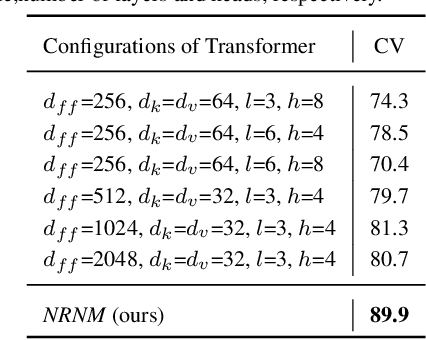

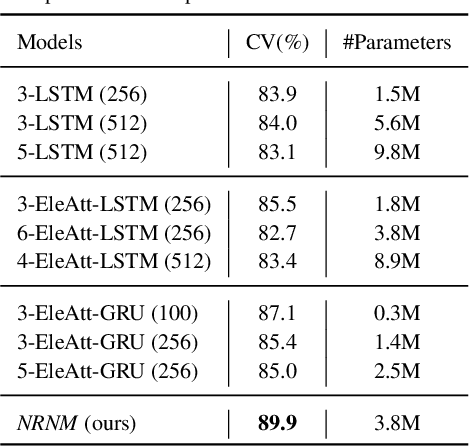
Abstract:The key challenge of sequence representation learning is to capture the long-range temporal dependencies. Typical methods for supervised sequence representation learning are built upon recurrent neural networks to capture temporal dependencies. One potential limitation of these methods is that they only model one-order information interactions explicitly between adjacent time steps in a sequence, hence the high-order interactions between nonadjacent time steps are not fully exploited. It greatly limits the capability of modeling the long-range temporal dependencies since the temporal features learned by one-order interactions cannot be maintained for a long term due to temporal information dilution and gradient vanishing. To tackle this limitation, we propose the Non-local Recurrent Neural Memory (NRNM) for supervised sequence representation learning, which performs non-local operations \MR{by means of self-attention mechanism} to learn full-order interactions within a sliding temporal memory block and models global interactions between memory blocks in a gated recurrent manner. Consequently, our model is able to capture long-range dependencies. Besides, the latent high-level features contained in high-order interactions can be distilled by our model. We validate the effectiveness and generalization of our NRNM on three types of sequence applications across different modalities, including sequence classification, step-wise sequential prediction and sequence similarity learning. Our model compares favorably against other state-of-the-art methods specifically designed for each of these sequence applications.
Non-local Recurrent Neural Memory for Supervised Sequence Modeling
Aug 26, 2019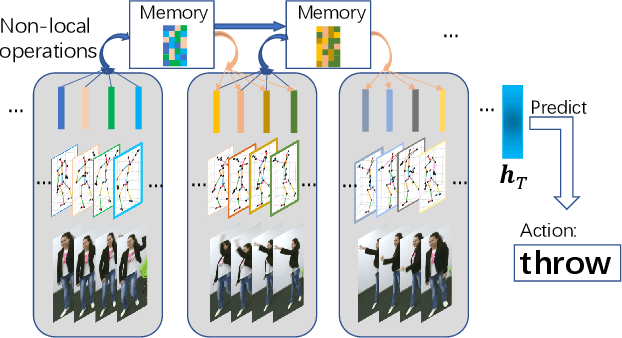
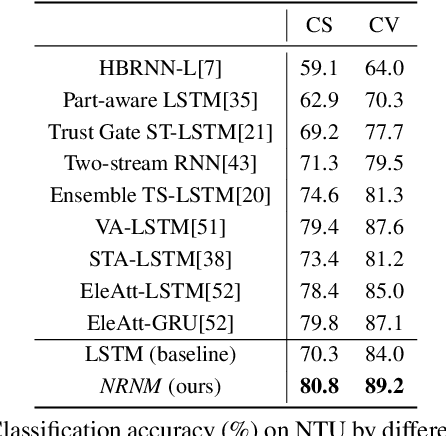
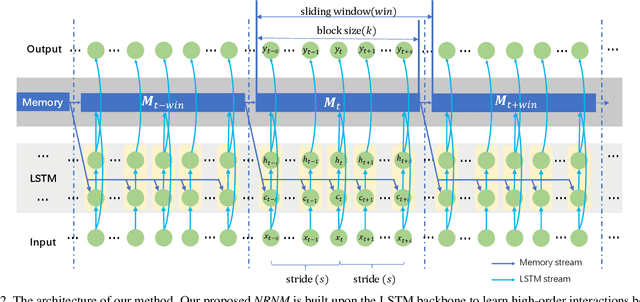
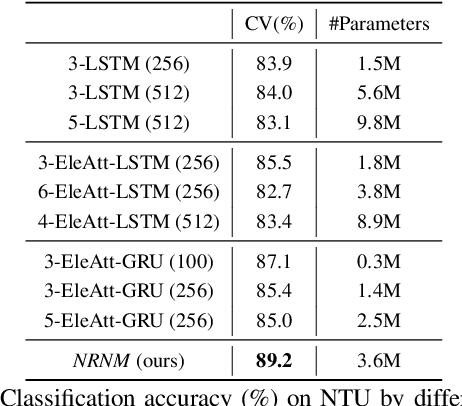
Abstract:Typical methods for supervised sequence modeling are built upon the recurrent neural networks to capture temporal dependencies. One potential limitation of these methods is that they only model explicitly information interactions between adjacent time steps in a sequence, hence the high-order interactions between nonadjacent time steps are not fully exploited. It greatly limits the capability of modeling the long-range temporal dependencies since one-order interactions cannot be maintained for a long term due to information dilution and gradient vanishing. To tackle this limitation, we propose the Non-local Recurrent Neural Memory (NRNM) for supervised sequence modeling, which performs non-local operations to learn full-order interactions within a sliding temporal block and models global interactions between blocks in a gated recurrent manner. Consequently, our model is able to capture the long-range dependencies. Besides, the latent high-level features contained in high-order interactions can be distilled by our model. We demonstrate the merits of our NRNM on two different tasks: action recognition and sentiment analysis.
Extend the shallow part of Single Shot MultiBox Detector via Convolutional Neural Network
Jan 18, 2018Abstract:Single Shot MultiBox Detector (SSD) is one of the fastest algorithms in the current object detection field, which uses fully convolutional neural network to detect all scaled objects in an image. Deconvolutional Single Shot Detector (DSSD) is an approach which introduces more context information by adding the deconvolution module to SSD. And the mean Average Precision (mAP) of DSSD on PASCAL VOC2007 is improved from SSD's 77.5% to 78.6%. Although DSSD obtains higher mAP than SSD by 1.1%, the frames per second (FPS) decreases from 46 to 11.8. In this paper, we propose a single stage end-to-end image detection model called ESSD to overcome this dilemma. Our solution to this problem is to cleverly extend better context information for the shallow layers of the best single stage (e.g. SSD) detectors. Experimental results show that our model can reach 79.4% mAP, which is higher than DSSD and SSD by 0.8 and 1.9 points respectively. Meanwhile, our testing speed is 25 FPS in Titan X GPU which is more than double the original DSSD.
 Add to Chrome
Add to Chrome Add to Firefox
Add to Firefox Add to Edge
Add to Edge